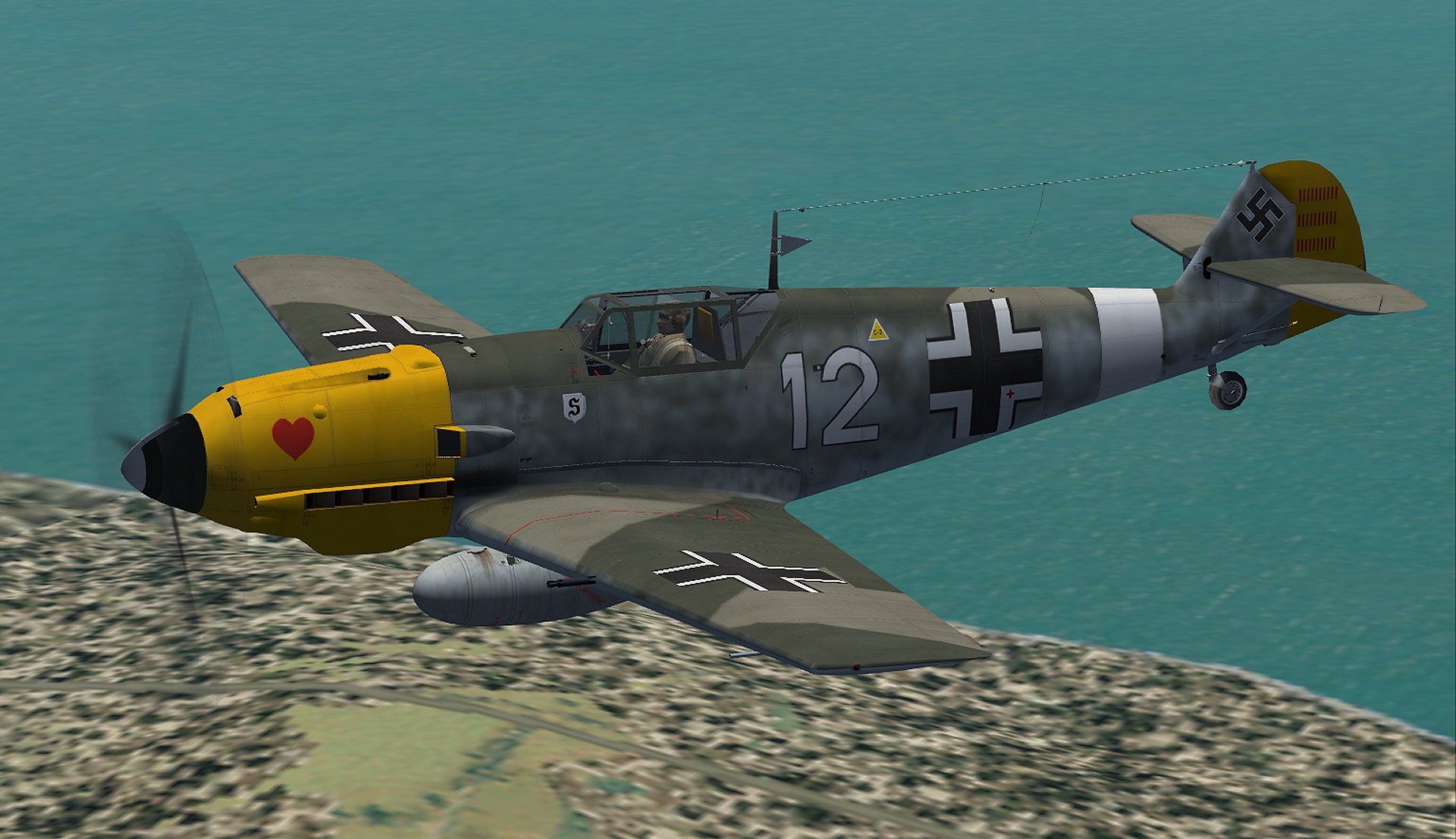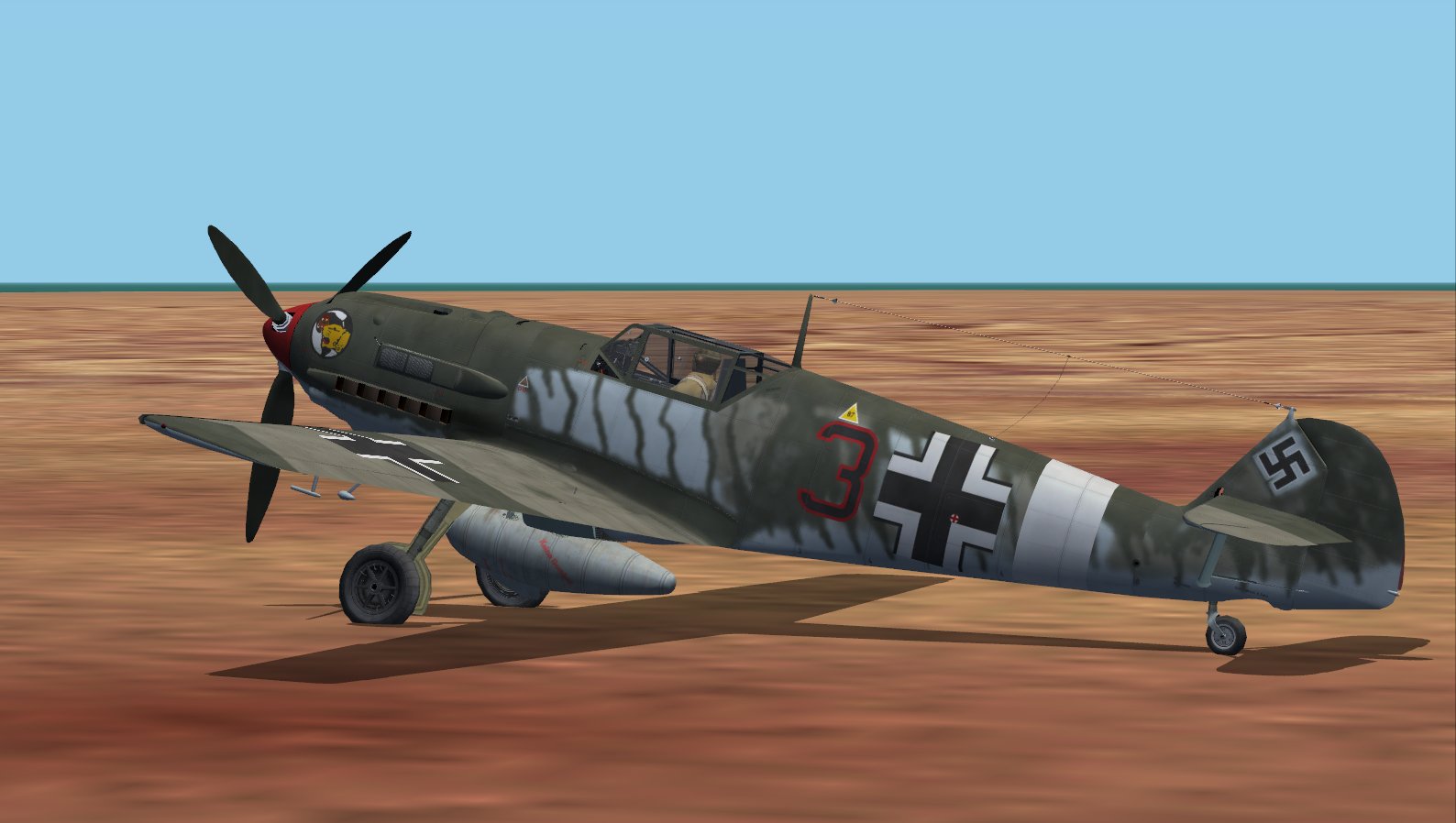Team Daedalus
Members +
Messerschmitt Bf 109E-7 3./(J)LG2

A new entry has been added to Add-Ons Library, category CFS 2 Aircraft - German
Description: Messerschmitt Bf 109E-7
by Design Team Daedalus
Unit: 3./(J)LG2 Calais-Marck, France Aug 1940
Pilot: unknown
Following the E-4, the E-7 was the next major production variant, entering service and seeing combat at the end of August 1940. One of the limitations of the earlier Bf 109Es was their short range of 660 km (410 mi) and limited endurance, as the design was originally conceived as a short-range interceptor. The E-7 rectified this problem as it was the first Bf 109 subtype to be able to carry a drop tank, usually the standardized Luftwaffe 300 L (79 US gal) capacity unit mounted on a centre-line rack under the fuselage, which increased its range to 1,325 km (820 mi). Fuel from the drop tank was pumped to the internal fuel tank via a large fuel line that ran up and along the inside starboard wall of the cockpit, with a clear sight glass located in the fuel line's main span so the pilot could easily see the flow of fuel and know when the tank was empty. Alternatively, a bomb could be fitted and the E-7 could be used as a Jabo fighter-bomber. Previous Emil subtypes were progressively retrofitted with the necessary fittings for carrying a drop tank from October 1940. Early E-7s were fitted with the 1,100 PS DB 601A or 1,175 PS DB 601Aa engine, while late-production ones received 1,175 PS DB 601N engines with improved altitude performance – the latter was designated as E-7/N. A total of 438 E-7s of all variants were built.
There were many small differences between individual E-7s because the E-7 was often modified in the field by groundcrew and rear area repair depots. The production standard had no pilot armor. Mods included types of pilot head armor, armored windscreen, tropical sand filters, etc.
So each model we have created has its own unique features. This aircraft was modified with a flat plate with curved top pilot head armor.
Pstrany is the primary model author with some small model refinement and additions by Captain Kurt as the model was collaborated on during development. Captain Kurt created the textures for each, the 2D instrument panel, the individual .dp files, air files and aircraft.cfg files.
To check it out, rate it or add comments, visit Messerschmitt Bf 109E-7 3./(J)LG2
The comments you make there will appear in the posts below.

A new entry has been added to Add-Ons Library, category CFS 2 Aircraft - German
Description: Messerschmitt Bf 109E-7
by Design Team Daedalus
Unit: 3./(J)LG2 Calais-Marck, France Aug 1940
Pilot: unknown
Following the E-4, the E-7 was the next major production variant, entering service and seeing combat at the end of August 1940. One of the limitations of the earlier Bf 109Es was their short range of 660 km (410 mi) and limited endurance, as the design was originally conceived as a short-range interceptor. The E-7 rectified this problem as it was the first Bf 109 subtype to be able to carry a drop tank, usually the standardized Luftwaffe 300 L (79 US gal) capacity unit mounted on a centre-line rack under the fuselage, which increased its range to 1,325 km (820 mi). Fuel from the drop tank was pumped to the internal fuel tank via a large fuel line that ran up and along the inside starboard wall of the cockpit, with a clear sight glass located in the fuel line's main span so the pilot could easily see the flow of fuel and know when the tank was empty. Alternatively, a bomb could be fitted and the E-7 could be used as a Jabo fighter-bomber. Previous Emil subtypes were progressively retrofitted with the necessary fittings for carrying a drop tank from October 1940. Early E-7s were fitted with the 1,100 PS DB 601A or 1,175 PS DB 601Aa engine, while late-production ones received 1,175 PS DB 601N engines with improved altitude performance – the latter was designated as E-7/N. A total of 438 E-7s of all variants were built.
There were many small differences between individual E-7s because the E-7 was often modified in the field by groundcrew and rear area repair depots. The production standard had no pilot armor. Mods included types of pilot head armor, armored windscreen, tropical sand filters, etc.
So each model we have created has its own unique features. This aircraft was modified with a flat plate with curved top pilot head armor.
Pstrany is the primary model author with some small model refinement and additions by Captain Kurt as the model was collaborated on during development. Captain Kurt created the textures for each, the 2D instrument panel, the individual .dp files, air files and aircraft.cfg files.
To check it out, rate it or add comments, visit Messerschmitt Bf 109E-7 3./(J)LG2
The comments you make there will appear in the posts below.









